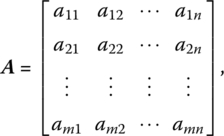2Mathematical Foundations
2.1 Matrix Algebra
We may define a matrix as an ordered set of elements arranged in a rectangular array of rows and columns. Thus a matrix A may be represented as

where aij, i = 1, …, m; j = 1, …, n, is the (representative) element in the ith row and jth column of A. Since there are m rows and n columns in A, the matrix is said to be “of order m by n” (denoted (m × n)). When m = n, the matrix is square and will simply be referred to as being “an nth order” matrix. To economize on notation, we may represent A in the alternative fashion
Oftentimes we shall need to utilize the notion of a matrix within a matrix, i.e. a submatrix is the (k × s) matrix B obtained by deleting all but k rows and s columns of an (m × n) matrix A.
Let us now examine some fundamental matrix operations. Specifically, the sum of two (m × n) matrices A = [aij], B = [bij] is the (m × n) matrix A + B = C = [cij], where cij = aij + bij, i = 1, …, m; j = 1, …, n, i.e, we add corresponding elements. Next, to multiply an (m × n) matrix A by a scalar λ we simply multiply each element of the matrix by the scalar or
(In view of these operations it is evident that A − B = A + (−1) B = ...
Get Linear Programming and Resource Allocation Modeling now with the O’Reilly learning platform.
O’Reilly members experience books, live events, courses curated by job role, and more from O’Reilly and nearly 200 top publishers.

